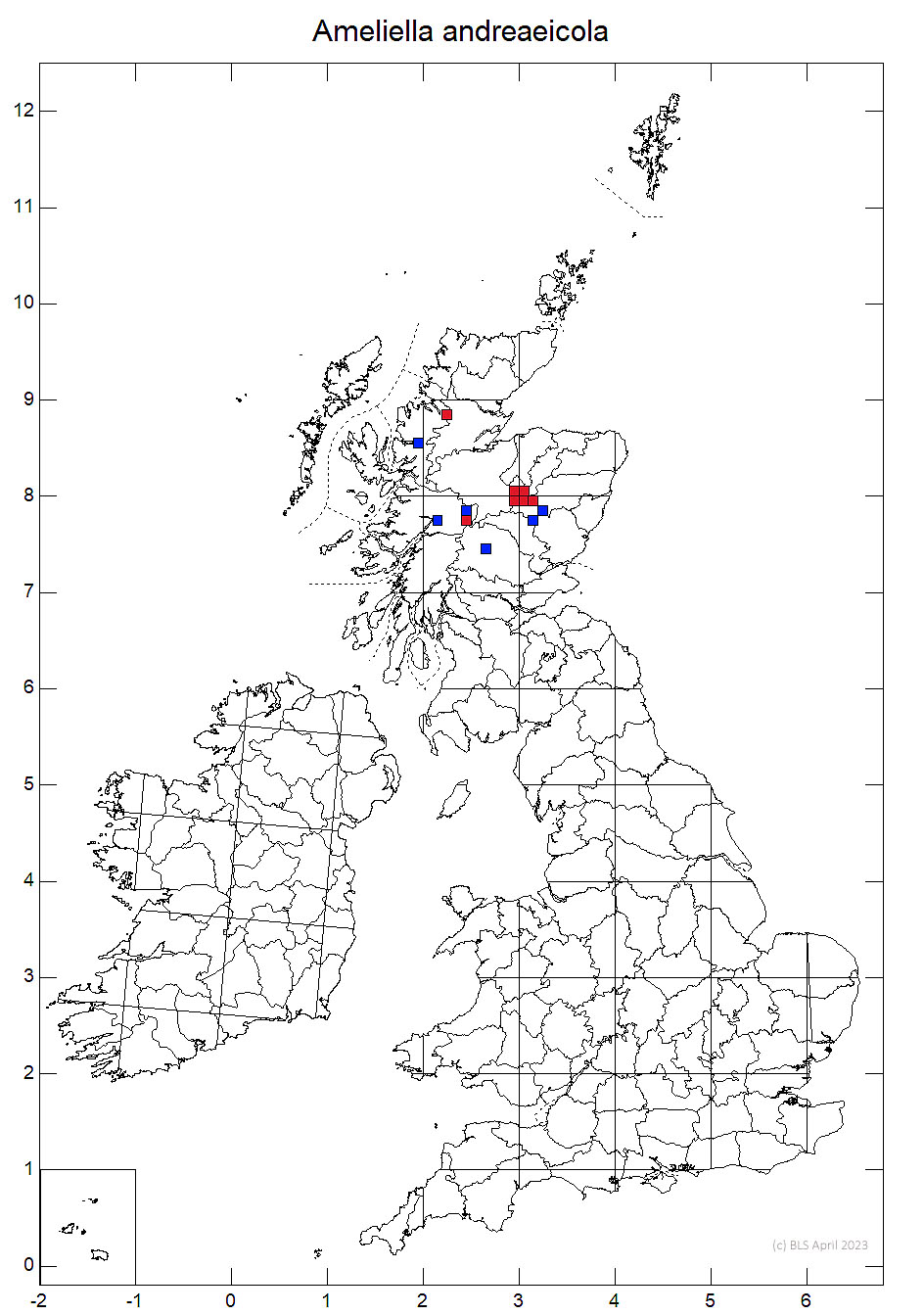Ameliella andreaeicola
A late snow patch specialist, usually overgrowing mosses, mainly Andreaea species on the flat upper surfaces of siliceous rocks around areas of late snow-lie in the Scottish Highlands at altitudes of 1000 m or more. Potentailly under long term threat from climate change.
Thallus forming small patches (to ca 2 cm diam.) of small verrucose to subsquamulose areoles 0.1–0.45 mm diam., which sometimes coalesce with the thallus which may become secondarily cracked, chestnut to dark brown (paler in shade) or occasionally greyish. Cortex thin, 5–7 μm thick, of brown-walled (K–, N–) rounded cells 3–3.5 μm diam., sometimes overlain by a colourless external layer 2–4 μm thick; photobiont chlorococcoid, cells (6–) 8–10 (–12) μm diam., or to 15 μm when dividing internally to form 4 (-8) autospores. Apothecia abundant, (0.1–) 0.2–0.4 mm diam.; disc chestnut to dark brown, usually with a paler proper exciple, flat to slightly convex, becoming strongly convex and distorted when over-mature; initially immersed in thalline warts and appearing only as a narrow slit; pseudothalline margin present in young apothecia but soon becoming excluded; true exciple a narrow indistinct zone, when well developed 10–20 μm thick, colourless but brown (K–, N–) or dull green (K+ brown, N+ red) pigmented at its outer edge, I+ deep blue or mauve, composed of outwardly radiating conglutinated hyphae with lumina 2–2.5 μm diam.; hymenium 100– 120 μm tall, I+ blue around the asci, but I± pale bluish elsewhere. Hypothecium hyaline, strongly conglutinated. Asci 45–50 × 17–22 μm. Ascospores narrowly ellipsoidal-fusiform, 18–24 × 5–7 μm, often wider at one end. Pycnidia rare, inconspicuous, 50–100 μm diam.; wall colourless or pale brown in part; conidiogenous cells 5–10 × ca 1.5 μm; conidia 11–12 × 0.7–1 μm.
Bryonora curvescens grows in similar habitats, but has much larger, ± sessile apothecia and longer ascospores. Ameliella grisea is similar but differs in the grey-white thallus and is found in more exposed habitats.
On mosses, usually overgrowing Andreaea species on the flat upper surfaces of siliceous rocks around areas of late snow-lie in the Scottish Highlands at altitudes of 1000 m or more

Occasional, central Highlands, rare north west Highlands
A late snow patch specialist, so under long term threat from climate change
Britain: Near Threatened
Cannon, P., Malíček, J., Ivanovich, C., Printzen, C., Aptroot, A., Coppins, B., Sanderson, N., Simkin, J. & Yahr, R. (2022). Lecanorales: Lecanoraceae, including the genera Ameliella, Bryonora, Carbonea, Claurouxia, Clauzadeana, Glaucomaria, Japewia, Japewiella, Lecanora, Lecidella, Miriquidica, Myriolecis, Palicella, Protoparmeliopsis, Pyrrhospora and Traponora. Revisions of British and Irish Lichens 25: 1-83.
Text by Neil A Sanderson, based on Cannon et al (2022)
